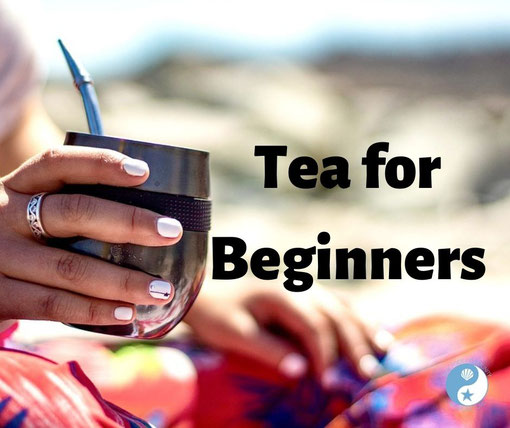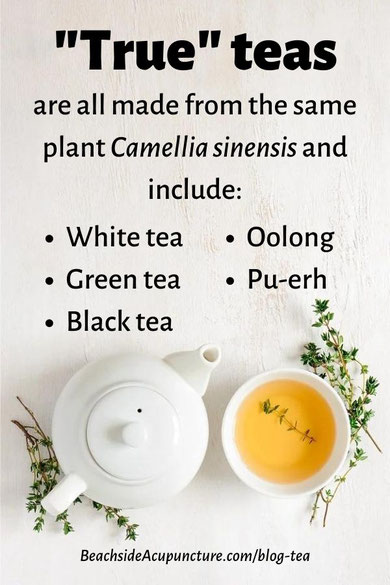
This post contains affiliate links, meaning Beachside Community Acupuncture PLLC may receive a small commission for purchases made through certain links at no additional cost to you. (In other words, you support us in a small way when you buy the products that we highly recommend and would use ourselves!) Click here to view our full disclosure policy.
From Japanese tea ceremonies to English high tea service, tea has been revered in cultures around the world for centuries. While many Americans prefer coffee, most at least know that tea can provide additional health benefits. The world of tea can seem overwhelming and confusing at first, but in the end it's worth the little bit of learning needed to enjoy it.
What Is Tea?
All "true" teas are made of leaves from the same plant Camellia sinensis but differ in their harvesting and processing. (Here processing means what happens to the leaves after they are picked - e.g. if they are dried or fermented - and doesn't imply any negative outcome like those you may associate with processed foods.) White, green, oolong, Pu-erh, and black teas all fall into this category, and all contain at least some caffeine.
Rooibos tea, also called red tea, is made from a shrub native to Africa, and herbal teas contain herbs from a variety of plants. These caffeine-free options are often included in a tea drinker's arsenal for their own health benefits or to combine with traditional tea to cut its caffeine content or create different flavors. You may also come across other types of tea, but these tend to be the most popular.

Types of Tea
You've probably heard comparisons between tea and coffee, but did you know each type of tea has its own unique attributes?
- White tea has the least caffeine and is known for its antioxidants.
- Green tea is arguably the most studied out of all of the teas. It is cooling in Traditional Chinese Medicine (TCM), and can be found in decaffeinated forms.
- Oolong tea is known for benefiting metabolism.
- Pu-erh tea is not as common in America. It usually has an aged, earthy flavor and can support the digestive system.
- Black tea is what most people imagine when they think of tea. Most iced teas found at restaurants are black tea, and household brands like Lipton are black tea as well. TCM considers black tea warming in nature.
- Rooibos tea can be helpful for those with allergies.
- Herbal teas provide a host of health benefits that are specific to the herbs used. For instance, peppermint tea can settle an upset stomach while chamomile tea can promote restful sleep.
No matter the type of tea, it's usually going to be healthier and of a higher quality if it's in loose leaf form instead of teabags. Think of a teabag: It looks like it's full of powder, and if you tear into one, its insides are grainy and dusty. It's no surprise that loose leaf tea - tea in its purest form, which looks like full leaves - is better for you. Loose leaf tea is usually bought in larger quantities of ounces to even pounds in tins or other packaging, but you can also find it in sachets (basically larger teabags that contain leaves instead of powder). You can buy loose leaf tea in health food stores like Whole Foods, but our favorite supplier is an online store called The Tea Spot.
How to Make Tea
Making tea can be as artistic or as routine as you'd like, and the "equipment" you'll need will be determined by your purpose for drinking tea in the first place. If you're having people over for afternoon tea or want to incorporate it into your morning meditation, for instance, you'll probably want a teapot. On the other hand, if you're just trying to add a healthy beverage to your diet, a small tea infuser (a canister to hold tea leaves as they're steeped in water) is probably enough.
Once you have your equipment, simply bring water to the start of a boil, take it off the heat by pouring it into a teacup or teapot, and then let your tea-filled infuser steep in it for the appropriate period of time. It's best to follow the instructions given with your specific tea, but you can also keep these general guidelines in mind...
- White tea: About two to three minutes
- Green tea: About two to three minutes but very delicate greens can be as little as 45 seconds
- Oolong tea: About three to four minutes
- Pu-erh: About three to five minutes
- Black tea: About three to five minutes
- Rooibos tea: At least five minutes
- Herbal tea: At least five minutes
If your tea is bitter, you've probably over-steeped it either by using water that was too hot - you should start to see a few little bubbles but not a full boil - or by waiting too long to take your infuser out. With trial and error you'll find the perfect method, and making a delicious cup will become second nature every time!
Of course, if this seems like too much work, you can buy a smart tea infuser that takes care of all of these intricacies for you. These machines let you set it and forget it, similar to coffee makers. A tea aficionado may fault you for taking the artistry out of tea brewing, but the convenience of these gadgets make them a great choice for people who are pressed for time.
However you choose to make your tea, know that you can reuse the leaves at least once more and compost them when they're spent. (Sachets can be saved to use again as well, but teabags should usually be tossed immediately.) The leaves will have less caffeine and a softer flavor the second time around, and purely herbal tea remnants can even be added to yogurts, oatmeal, and smoothies.
Be Adventurous
Once you dive into the vast tea culture, it can be very addictive! After knowing the basics, you can explore teas based on regions like Assam, Ceylon, and Darjeeling or try different flavor profiles to challenge your taste buds. You can grow your own herbs to make fresh tea at home or venture out to a tearoom to take part in a more "proper" tea service. Tea can be used to promote rest in downtime or bring people together for a celebration. The possibilities are endless; all it takes is an open mind and a willingness to learn.

Kathleen Ketola is a Licensed Acupuncturist and the owner of Beachside Community Acupuncture. She loves providing affordable acupuncture to the residents of McKinney, Texas, and surrounding cities like Prosper, Frisco, and Plano, but she also enjoys educating the general public on how acupuncture and Traditional Chinese Medicine (TCM) can treat everything from pain to infertility to stress and beyond. Click "Book Now" at the top of this page to book an appointment or feel free to contact her at (214) 417-2260.









